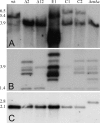Mid1, a mechanosensitive calcium ion channel, affects growth, development, and ascospore discharge in the filamentous fungus Gibberella zeae
- PMID: 21357477
- PMCID: PMC3127676
- DOI: 10.1128/EC.00235-10
Mid1, a mechanosensitive calcium ion channel, affects growth, development, and ascospore discharge in the filamentous fungus Gibberella zeae
Abstract
The role of Mid1, a stretch-activated ion channel capable of being permeated by calcium, in ascospore development and forcible discharge from asci was examined in the pathogenic fungus Gibberella zeae (anamorph Fusarium graminearum). The Δmid1 mutants exhibited a >12-fold reduction in ascospore discharge activity and produced predominately abnormal two-celled ascospores with constricted and fragile septae. The vegetative growth rate of the mutants was ∼50% of the wild-type rate, and production of macroconidia was >10-fold lower than in the wild type. To better understand the role of calcium flux, Δmid1 Δcch1 double mutants were also examined, as Cch1, an L-type calcium ion channel, is associated with Mid1 in Saccharomyces cerevisiae. The phenotype of the Δmid1 Δcch1 double mutants was similar to but more severe than the phenotype of the Δmid1 mutants for all categories. Potential and current-voltage measurements were taken in the vegetative hyphae of the Δmid1 and Δcch1 mutants and the wild type, and the measurements for all three strains were remarkably similar, indicating that neither protein contributes significantly to the overall electrical properties of the plasma membrane. Pathogenicity of the Δmid1 and Δmid1Δcch1 mutants on the host (wheat) was not affected by the mutations. Exogenous calcium supplementation partially restored the ascospore discharge and vegetative growth defects for all mutants, but abnormal ascospores were still produced. These results extend the known roles of Mid1 to ascospore development and forcible discharge. However, Neurospora crassa Δmid1 mutants were also examined and did not exhibit defects in ascospore development or in ascospore discharge. In comparison to ion channels in other ascomycetes, Mid1 shows remarkable adaptability of roles, particularly with regard to niche-specific adaptation.
Figures







References
-
- Alberghina A., Benni A. 1980. Different sensitivity to mitochondrial inhibitors of respiration in Fusarium oxysporum and Fusarium solani. Phytopathol. Z. 99:138–145
-
- Basile L. J., Willson R. C., Sewell B. T., Benedik M. J. 2008. Genome mining of cyanide-degrading nitrilases from filamentous fungi. Appl. Microbiol. Biotechnol. 80:427–435 - PubMed
-
- Berridge M. J., Bootman M. D., Roderick H. L. 2003. Calcium signalling: dynamics, homeostasis and remodelling. Nat. Rev. Mol. Cell Biol. 4:517–529 - PubMed
-
- Bistis G. N. 1981. Chemotropic interactions between trichogynes and conidia of opposite mating-type in Neurospora crassa. Mycologia 73:959–975
Publication types
MeSH terms
Substances
LinkOut - more resources
Full Text Sources

